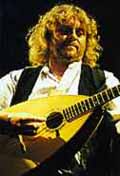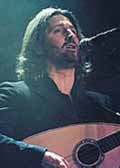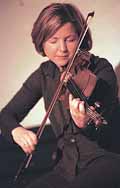 |
||
The Living Tradition
|
|
|||
| Bill Lamey -
Bringing it back home |
|
|||
|
{graphic} |
||||
|
The dynamic sound of the Cape Breton fiddler is now a familiar feature at festivals and concerts everywhere. But the name of Bill Lamey, the first man to bring the music back to Scotland in the 1960s, is unfamiliar to most. A recent Rounder CD features recordings of him made at 'house sessions' and provides a fascinating insight into the life of a master Cape Breton fiddler. In 1963 most Scottish fiddle players didn't know that Cape Breton even existed, far less that it was home to a fiddle tradition with a strong claim to be closer to the old Highland style than anything surviving in Scotland. So the sound of the home-recorded tape of Cape Breton fiddler Bill Lamey must have come as a bombshell to the fifty or so fiddle players gathered at a ceilidh in Aberdeen. Herbie McLeod, who had made the recording, recalls "all the great players were there. I didn't know one from another, but I realised later how great they were. Hector Mac Andrew, Bill Hardie - and this fellow, Ron Gonella." Listening to that recording now, you can't help wondering what Ron Gonella - renowned for his immaculate playing and beautiful tone - made of Bill Lamey's style which gives top priority to the rhythm and drive needed for dancing. Though Bill had played for many years with piano accompaniment, his playing retains all the hallmarks of the days when the unaccompanied fiddler had to rely on his own resources to energize the dancers. The bowing has a strong attack with a slight whip in each bow stroke, drones and double stopping are used for a full sound, and frequent use of snappy triplets emphasises the dance rhythms further. The reception Bill got when he appeared in person at the Mod in Inverness later that year was extraordinary. "Bill went up on the stage and started playing traditional, the way he did, and the people were shell shocked. When he got through they stood up and clapped and clapped and wouldn't let him sit down." People marvelled at the way Cape Breton fiddlers had kept the tradition of 'the cutting of the bow' (rhythmic use of triplets) and syncopation in their playing, while these techniques had largely been lost in Scotland. One older woman said "we haven't got that music at all - we have never heard the like in years - we lost that, it's gone." Bill was proud of his Highland heritage. Stories passed down through the family on his mother's side told how his great-grandmother Catherine Stewart MacVarish and her husband were among the many thousands sent off on 'coffin ships' during the Highland Clearances. She was pregnant with Bill's grandmother at the time. "They left there about 1834. And it had not been easy for them in that part. My grandmother told the story, how they had one or two cows, and no meat to butcher, so she used to bleed the cattle to make the pudding - the marag (black pudding). And there were two children buried there in infancy. But they were very sad leaving, when the boat started pulling away from Fort William." (Bill was also proud his Irish ancestry on his father's side, but it was not a great influence on his music.) Bill Lamey was born in 1914 and decided at an early age that he would like to take up music. His family couldn't afford music lessons, so he tried to learn from a cousin who was taking lessons. Later he joined the town band in Sydney, Cape Breton, so that he could learn to read music - on the trumpet! He was 18 years old before he got a fiddle. His mother loved and knew traditional music well, and encouraged him by using puirt-a-beul (mouth music) to teach him any tunes he was having difficulty with. He spent hours practicing, and watching other fiddle players. Mary MacDonald, a classic fiddle player in the 'old Gaelic style' was one of his greatest heroes. Bill must have been a quick learner. After a couple of years or so he was given his own show on the Sydney radio station with a group which included fiddler Joe McLean and pianist Lila Hashem. (Both are featured with Bill on a 78 from 1947 reproduced on the CD). Bill and Joe were to become close friends, and played together throughout the 1930s and 40s. They were in great demand for Cape Breton square dances. In the summertime, parish picnics were a regular feature at weekends with dancing starting at 11 am and going on to 1 am the following morning. This left Bill with just enough time to drive home and change in time to get to his day job at the Sydney bakery. 'House sessions', where anything from two or three fiddle players upwards got together with a small appreciative audience, were a vital element of Cape Breton traditional music. Listeners were an important part of the sessions for Bill. "What the hell would we be doing if we didn't have any listeners? If the world was full of fiddlers and no listeners…" Bill and Joe had regular Sunday sessions in Finlay Cameron's house in Boisdale along with fellow fiddlers Dan R. MacDonald and Donald MacLellan. Father John Angus Rankin, a local priest and enthusiastic piano player was addicted to these sessions. "Any fiddle player that knew me, I think they'd rather see the devil coming than see me. You can get rid of the devil with a shot of holy water, but it'll take three or four hours of Scotch music to get rid of me." The sessions started at 2 o'clock in the afternoon and often went through to 3 or 4 in the morning, with just a short break for Father John's duties - "You never saw such a fast rosary and benediction in your life!" Sometimes the sessions went on so long that he went straight on to taking early morning mass. Father John became a firm friend of Bill's and accompanied him on his first trip to Scotland (as he was to accompany Buddy MacMaster on his first trip there in 1970). There were sessions at many other houses too. Bill and Dan R. McDonald were among the fiddle players who regularly visited the MacMaster household and influenced the young Buddy in his formative years. Bill and Joe had a passion for searching books of music from Scotland to find 'new' tunes. A few Cape Breton fiddlers like Dan R. MacDonald served in Scotland during World War 2 and brought back any books they could find. Bill had great respect for composers and was renowned for following the bowing instructions faithfully to make sure that everything was there as the composer intended - though the sound is still quite different to what a Scottish player using the same bowing would produce. His style on slow airs - which were not much played in Cape Breton before World War 2 is particularly distinctive - he plays freely and with emotion but with no feeling of sentimental lingering over notes. In 1953 Bill moved to Boston, as so many from Cape Breton had before. He soon became a leading light in the city's Cape Breton community. His whole family was involved in running Cape Breton square dances there for almost 20 years, with Bill leading the playing naturally. He hosted his own radio programme in Boston for several years - a programme which was avidly listened to back in Cape Breton. And of course there were the inevitable house sessions at the Lamey household and elsewhere - particularly if guest musicians were in town. His regular pianist at this time was Mary Jessie MacDonald - a great innovator in Cape Breton piano playing. After moving to Boston she had begun to incorporate techniques from the Jazz pianists she heard there, including walking bass lines and syncopation. But she combined this with a great understanding of the tradition, developed by accompanying her mother - none other than the Mary MacDonald whose traditional style Bill admired so much. (The CD includes some 1956 house session recordings of her accompanying Bill - the sound is not as clear as the later sessions, but they are classic examples of the Cape Breton fiddler and pianist in real partnership). When Bill came to Scotland in 1963 the BBC pressed him to record some tapes for them. Unfortunately for us he refused, saying he had come to see Scotland, not make tapes. Most likely he had been sickened of recording by his experiences in the 1940s and 50s when he had to record direct to masters. In 1984 he recalled what it was like rehearsing for hours for the recording engineer to get the balance right: "Watching the needle go back and forth from nine o'clock at night till one o'clock in the morning when he finally said go. I wasn't allowed to play but the tune I was going to record. Now if you play the same tune for three hours, wouldn't you be pretty sour, eh! And make no mistakes!" Another frustration was being limited to two or three tunes. Usually, at home or at a dance, a Cape Breton fiddler would play a string of several tunes - for 5 to 10 minutes straight through. Bill's 78s are regarded as classics, but it's not surprising that as soon as cheap reel to reel tape recorders became widely available, he and other Cape Breton players started making tapes in the more natural environment of the 'house session' and distributing them to other players. For a while in the 50s and 60s these tapes were a major way of spreading tunes and styles amongst Cape Breton musicians. Jerry Holland, another fine player who was greatly influenced by Bill, still knew his tapes by heart many years afterwards. Bill also gave him great personal encouragement when he was growing up. Sadly Bill never played in Scotland again. The next time he arrived, in 1977, he had his arm in a sling as a result of a long house session in London which had aggravated chronic muscle and tendon problems. He played little after that. He retired to Cape Breton in 1983, and died there in 1991. By then Cape Breton fiddle playing was widely recognised not only in its ancestral home of Scotland, but also around the world. Many players can take credit for this, but it was Bill Lamey who laid the foundations. Richard Brown
|
||||
|
Links, further information and recordings: Bill Lamey: Full Circle - From Cape Breton to Boston and Back: Classic House Sessions of Traditional Cape Breton Music 1956-1977. Rounder 82161-7032-2. Essential for any lover of Cape Breton fiddling who is more concerned with the feeling of the playing than with modern recording standards. The 35-page insert booklet - which supplied most of the information for this article - is almost worth the price on its own. Buddy McMaster: The
Judique Flyer - Greentrax:CDTRAX 203 Up to the minute recording of
the last of the great old time Cape Breton fiddlers - and still a master
player. Features 14 different piano players and a 20+ page insert booklet
covering both Buddy and Cape Breton piano styles. (Catch Buddy live to
get that feeling of playing all night long for the sheer enjoyment of
it.) |



